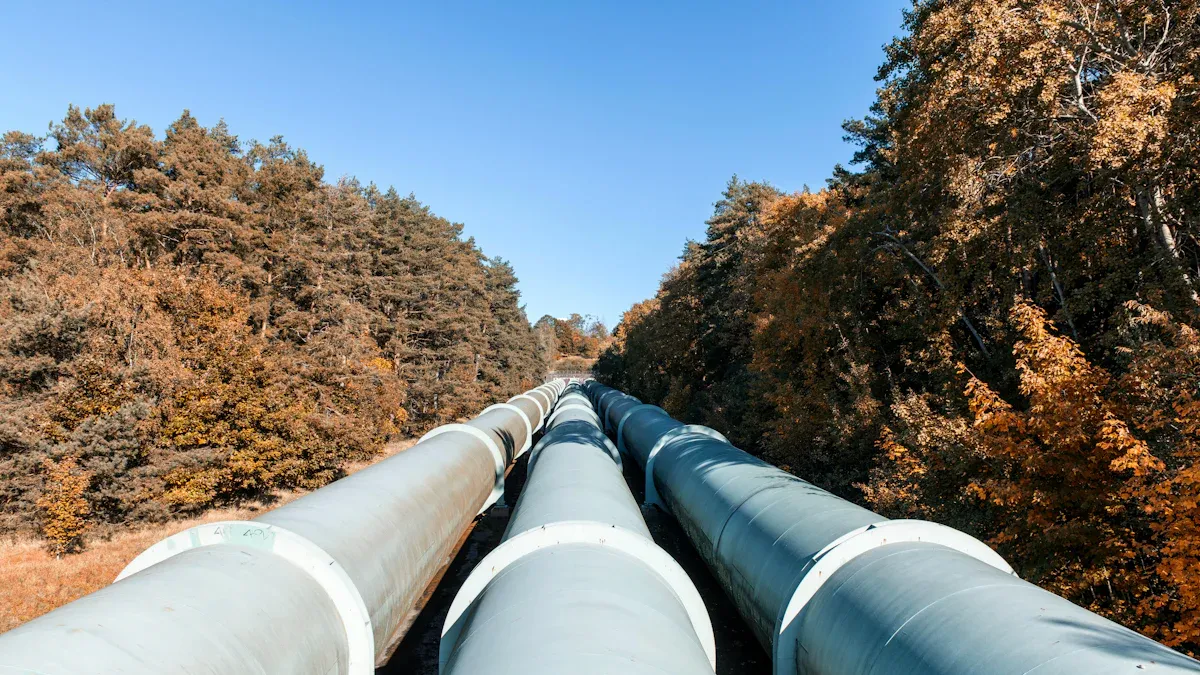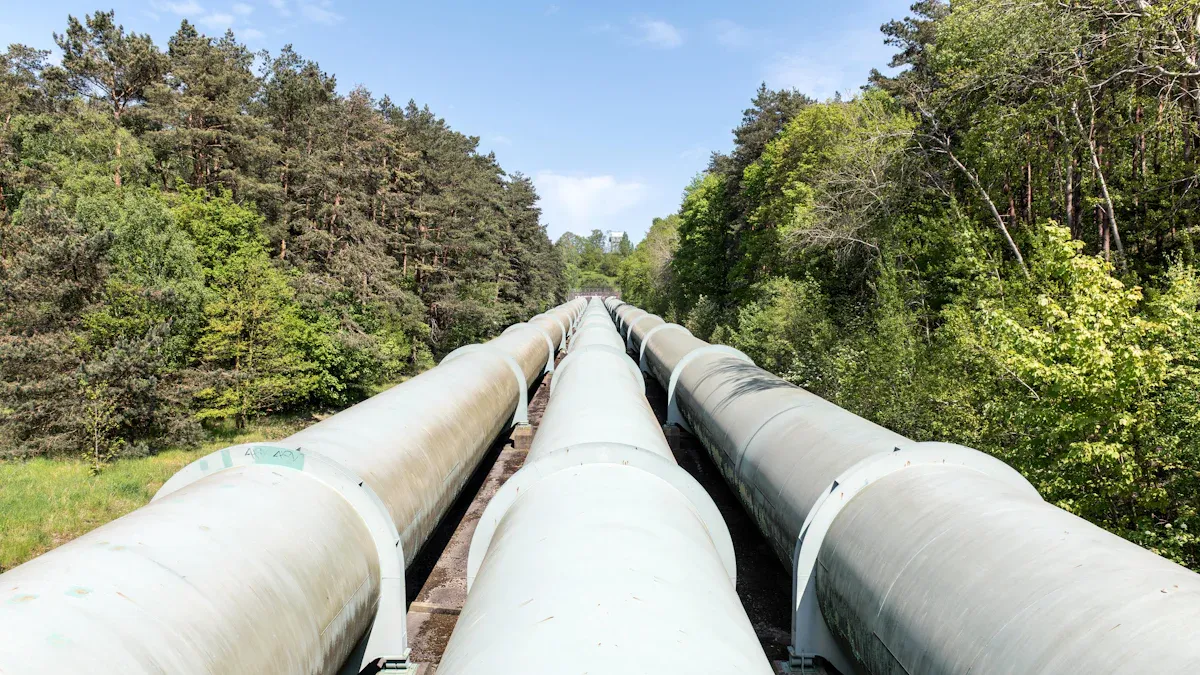
High-temperature fiber optic cable plays a vital role in oil and gas pipelines. Modern outdoor fiber optic cable and underground fiber optic cable withstand pressures up to 25,000 psi and temperatures up to 347°F. Fiber cable enables real-time, distributed sensing, providing accurate data for pipeline safety and operational efficiency.
Key Takeaways
- High-temperature fiber optic cables withstand extreme heat, pressure, and chemicals, enabling safe and efficient monitoring of oil and gas pipelines.
- Distributed sensing technologies like DTS and DAS provide real-time data to detect leaks, blockages, and other issues early, reducing risks and costs.
- Choosing the right cable type and coating ensures reliable performance in harsh environments, supporting long-term pipeline safety and operational success.
Fiber Optic Cable Challenges and Requirements in Oil & Gas Pipelines

High Temperatures and Corrosive Environments
Oil and gas pipelines expose fiber optic cable to extreme conditions. Operators demand cables that withstand high temperatures, intense pressure, and corrosive chemicals. The following table highlights key performance statistics for cables used in these environments:
| Parameter / Feature | Details / Statistics |
|---|---|
| Operational Temperature Range | Exceeds 300°C for downhole sensing fibers |
| Pressure Resistance | Up to 25,000 psi in unconventional reservoirs |
| Corrosion Resistance Features | Hydrogen-darkening immunity, carbon-coated fibers for hydrogen-induced attenuation |
| Coating Technologies | Polyimide, carbon, and fluoride coatings enhance chemical resistance |
| Regulatory Temperature Standards | -55°C to 200°C, up to 260°C in aerospace, 175°C for 10 years (Saudi Aramco SMP-9000 spec) |
| Specialized Applications | Subsea well monitoring, offshore drilling, petrochemical plants |
Real-Time Monitoring and Data Accuracy
Fiber optic cable enables continuous, real-time monitoring of temperature, pressure, and strain along pipelines. Distributed fiber optic sensing (DFOS) technology detects anomalies and leaks over long distances, supporting immediate intervention and risk mitigation. Operators have used distributed temperature and acoustic sensing to monitor cement integrity, identify cross flow between reservoir zones, and detect plugged inflow control devices. These applications improve productivity and reduce intervention time. Fiber optic cable systems deliver high bandwidth and immunity to electromagnetic interference, ensuring reliable data transmission for remote monitoring.
Safety, Reliability, and Compliance
Pipeline operators face several challenges when installing and maintaining fiber optic cable systems:
- Precise sensor installation is critical to avoid disturbing fluid flow.
- Fiber Bragg Grating sensors become costly for long pipelines.
- Distributed fiber optic sensors require complex layout designs.
- The viscoelastic behavior of materials like HDPE complicates measurement accuracy.
- Distributed Acoustic Sensing methods need advanced signal processing due to variable vibrational signatures.
- Sensor networks in remote areas require reliable energy supply and add to operational costs.
Note: Fiber optic cable solutions help operators meet regulatory standards, enhance safety, and ensure reliable operation in harsh environments.
Fiber Optic Cable Technologies and Solutions for High Temperatures
Distributed Temperature Sensing (DTS) and Distributed Acoustic Sensing (DAS)
Distributed Temperature Sensing (DTS) and Distributed Acoustic Sensing (DAS) have transformed pipeline monitoring in the oil and gas industry. DTS uses the scattering of light within a fiber optic cable to measure temperature changes along its entire length. This technology provides continuous, high-resolution thermal profiles, which are essential for detecting leaks, blockages, or abnormal heat signatures in pipelines. Recent advancements in DTS include active methods, such as deploying heat sources to enhance sensitivity. These methods—thermal advection tests, hybrid cable flow logging, and heat pulse tests—offer operators the ability to monitor deep wells with high spatial and temporal resolution. DTS outperforms traditional point sensors, especially in high-temperature environments where accurate, distributed data is critical.
DAS, on the other hand, detects acoustic signals and vibrations along the fiber optic cable. This system can monitor thousands of points simultaneously, capturing events such as leaks, flow changes, or unauthorized activities. DAS measures longitudinal strain with directional sensitivity, but its performance depends on factors like fiber orientation and strain coupling efficiency. In high-temperature settings, the mechanical and optical properties of the cable may change, requiring robust design and advanced signal processing. Together, DTS and DAS enable real-time, distributed monitoring, supporting proactive maintenance and rapid response to incidents.
Dowell integrates DTS and DAS technologies into its high-temperature fiber optic cable solutions, ensuring reliable performance in the most demanding oil and gas environments.
Types of High-Temperature Fiber Optic Cable
Selecting the right fiber optic cable for high-temperature applications involves understanding the unique challenges of oil and gas pipelines. Manufacturers design specialty optical fibers to withstand extreme temperatures, corrosive chemicals, and high-pressure hydrogen-rich environments. The following table summarizes common types of high-temperature fiber optic cable and their key features:
| Cable Type | Temperature Range | Coating Material | Application Area |
|---|---|---|---|
| Polyimide-coated Fiber | Up to 300°C | Polyimide | Downhole sensing, well monitoring |
| Carbon-coated Fiber | Up to 400°C | Carbon, Polyimide | Hydrogen-rich environments |
| Metal-coated Fiber | Up to 700°C | Gold, Aluminum | Extreme temperature zones |
| Fluoride Glass Fiber | Up to 500°C | Fluoride Glass | Specialized sensing applications |
Engineers often deploy these cables in permanent installations, such as well casings, wireline logging cables, and slickline cables. The choice of coating and fiber type depends on the specific temperature, chemical exposure, and mechanical stress expected in the field. Dowell offers a comprehensive portfolio of high-temperature fiber optic cable solutions, tailored to meet the rigorous demands of oil and gas operations.
Real-World Applications and Benefits
High-temperature fiber optic cable solutions deliver significant benefits across the oil and gas value chain. Operators use distributed sensing technologies—DTS, DAS, and Distributed Vibration Sensing (DVS)—to monitor downhole activities, including hydraulic fracturing, drilling, and production. These systems provide real-time insights into well performance, enabling operators to maximize output and reduce downtime.
- Specialty fiber optic cables endure harsh conditions, including high temperatures and corrosive chemicals.
- Distributed sensing enables continuous monitoring for leak detection, flow measurement, and reservoir management.
- Operators achieve early detection of leaks or blockages, reducing environmental risk and maintenance costs.
- Fiber optic cable systems replace multiple point sensors, simplifying installation and lowering long-term expenses.
- Permanent installations in well casings and pipelines ensure reliable, long-term data collection.
A comprehensive numerical study, supported by experimental field tests, demonstrates the effectiveness of high-temperature fiber optic cable technologies in monitoring buried high-pressure natural gas pipelines. Researchers used advanced simulation methods and found that cables placed within 100 mm of the pipeline reliably detected leakage-induced temperature changes. The study recommends laying four fiber optic cables evenly around the pipeline circumference for optimal coverage. Experimental results closely matched simulations, confirming the feasibility and accuracy of this approach for high-pressure pipeline leakage detection.
Peer-reviewed studies and technical papers document the ongoing innovation in fiber optic sensing technologies. These works validate the reliability and effectiveness of distributed temperature sensing and fiber optic sensors in harsh oilfield environments. Sensuron’s Fiber Optic Temperature Sensing (FOSS) systems, for example, provide continuous, high-resolution temperature monitoring along pipelines, enabling early detection of leaks or blockages. The technology’s chemical inertness and immunity to electromagnetic interference make it ideal for oil and gas applications. Operators benefit from improved efficiency, reduced downtime, and overall cost savings, despite higher initial investments.
Companies like Dowell continue to advance fiber optic cable solutions, helping operators achieve safer, more efficient, and more reliable pipeline operations.
Selecting the right high-temperature cable ensures safe and efficient pipeline operations. Real-world deployments highlight key benefits:
- Early threat detection through advanced monitoring systems.
- Reliable surveillance with integrated audio and video recognition.
- Improved risk management using predictive models for pipeline failures.
Consulting industry experts helps operators achieve compliance and long-term reliability.
By: Eric
Tel: +86 574 27877377
Mb: +86 13857874858
E-mail: henry@cn-ftth.com
Youtube: DOWELL
Pinterest: DOWELL
Facebook: DOWELL
Linkedin: DOWELL
Post time: Jul-09-2025
